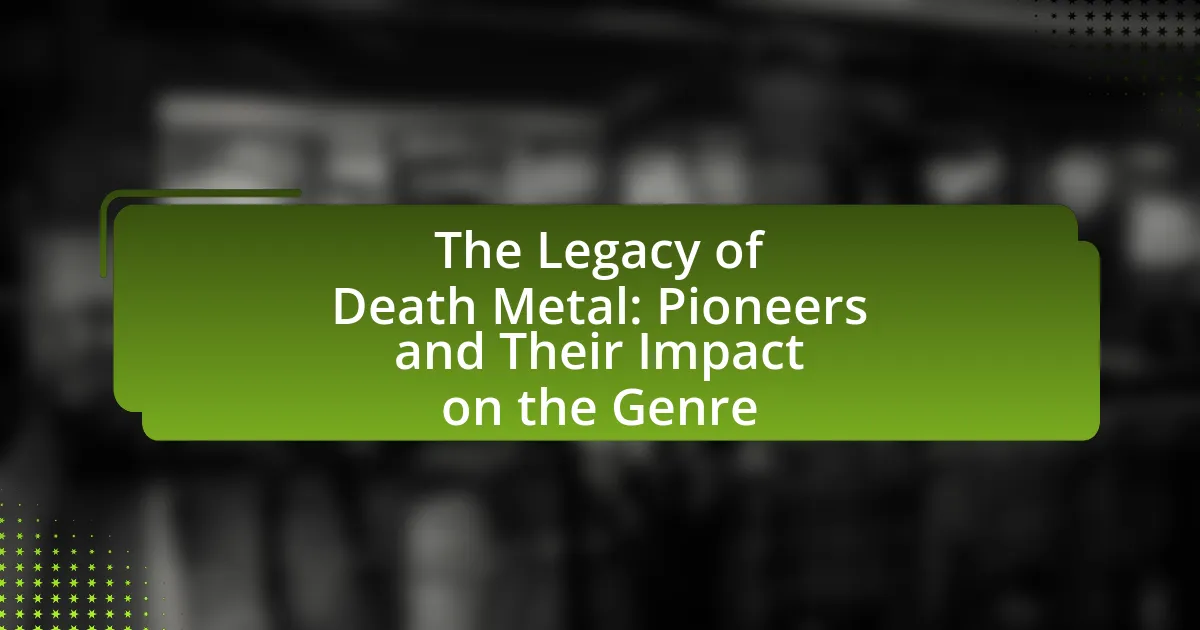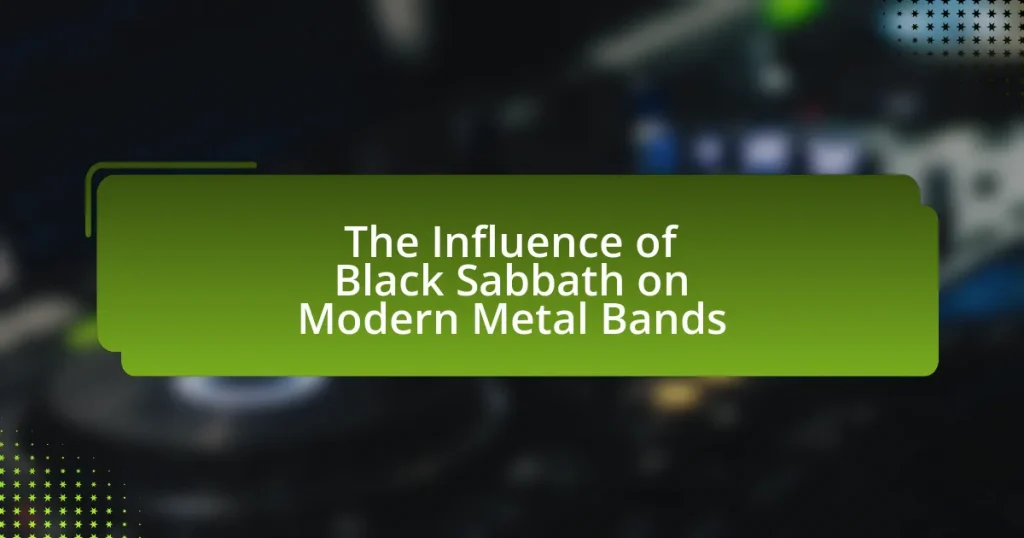The article examines the legacy of death metal, a genre that emerged in the mid-1980s and has significantly influenced the evolution of extreme music. It highlights the pioneering contributions of key bands such as Death, Morbid Angel, and Cannibal Corpse, detailing their impact on the genre’s sound, themes, and cultural identity. The discussion includes the defining characteristics of death metal, its evolution over time, and its influence on contemporary music and subgenres. Additionally, the article explores the cultural significance of death metal, its community, and the ongoing trends within the genre, providing insights into how aspiring musicians can draw inspiration from its pioneers.
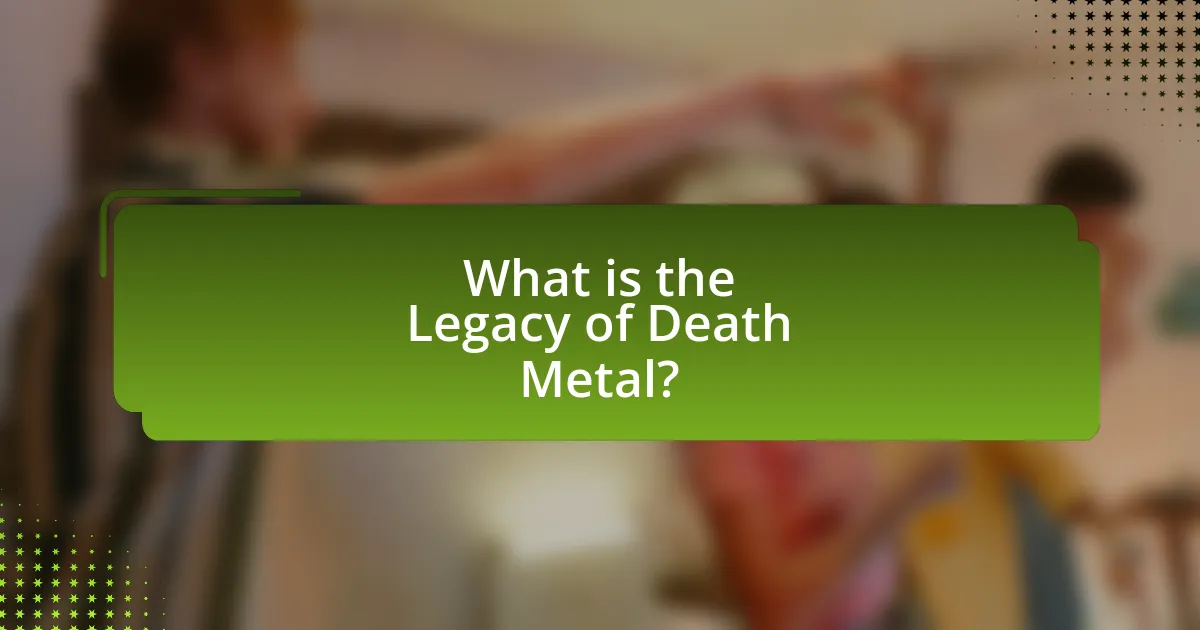
What is the Legacy of Death Metal?
The legacy of death metal is characterized by its profound influence on the evolution of extreme music genres and its role in shaping the broader metal landscape. Originating in the mid-1980s, bands like Death, Morbid Angel, and Cannibal Corpse pioneered a sound marked by aggressive guitar riffs, complex song structures, and guttural vocals, which set a new standard for heaviness and technicality in music. This genre not only inspired countless subgenres, such as technical death metal and melodic death metal, but also contributed to the rise of underground music scenes globally. The impact of death metal is evident in its enduring popularity, with festivals dedicated to the genre and a dedicated fanbase that continues to grow, showcasing its lasting relevance in the music industry.
How did Death Metal originate and evolve over time?
Death Metal originated in the mid-1980s as a subgenre of heavy metal, characterized by its aggressive sound, deep growling vocals, and complex guitar riffs. Bands like Death, Possessed, and Morbid Angel were instrumental in shaping the genre’s early sound, with Death’s 1987 album “Scream Bloody Gore” often cited as one of the first true Death Metal records. Over time, Death Metal evolved through the incorporation of various influences, including Thrash Metal and Black Metal, leading to subgenres such as Melodic Death Metal and Technical Death Metal. The genre gained popularity in the 1990s, with bands like Cannibal Corpse and Obituary achieving commercial success, further solidifying Death Metal’s place in the heavy music landscape. The evolution continued into the 2000s and beyond, with a focus on technical proficiency and experimentation, as seen in the works of bands like The Black Dahlia Murder and Necrophagist.
What are the defining characteristics of Death Metal music?
Death Metal music is characterized by its heavy use of distorted guitars, deep growling vocals, complex song structures, and aggressive drumming. The genre often features themes of death, violence, and the macabre, which are reflected in the lyrical content. Additionally, Death Metal incorporates intricate guitar solos and rapid tempo changes, distinguishing it from other metal genres. Historically, bands like Death and Morbid Angel have been pivotal in shaping these characteristics, influencing the genre’s evolution and establishing a distinct sound that is recognized worldwide.
Who were the key bands involved in the early development of Death Metal?
The key bands involved in the early development of Death Metal include Death, Possessed, Morbid Angel, and Cannibal Corpse. Death, formed in 1983, is often credited with pioneering the genre through their album “Scream Bloody Gore” released in 1987, which established many of the stylistic elements of Death Metal. Possessed’s 1985 album “Seven Churches” is recognized as one of the first Death Metal albums, influencing the sound and lyrical themes of the genre. Morbid Angel, emerging in the late 1980s, contributed significantly with their album “Altars of Madness” in 1989, which showcased complex song structures and technical musicianship. Cannibal Corpse, formed in 1988, became known for their graphic lyrics and aggressive sound, solidifying their place in the genre’s development with albums like “Eaten Back to Life” in 1990. These bands collectively shaped the sound, themes, and cultural identity of Death Metal, establishing a foundation for future artists.
Why is the legacy of Death Metal significant in the music industry?
The legacy of Death Metal is significant in the music industry because it has profoundly influenced the evolution of extreme music genres and shaped the broader metal landscape. Originating in the late 1980s, bands like Death and Morbid Angel pioneered complex song structures, aggressive instrumentation, and lyrical themes that pushed the boundaries of musical expression. This genre introduced technical proficiency and innovation, which have been adopted by countless subgenres, including technical death metal and deathcore. The impact of Death Metal is evidenced by its enduring popularity and the emergence of festivals dedicated to the genre, such as Maryland Deathfest, which showcases its lasting appeal and cultural relevance.
How has Death Metal influenced other music genres?
Death Metal has significantly influenced other music genres by introducing complex song structures, aggressive vocal styles, and intricate guitar work. For instance, genres like Metalcore and Progressive Metal have adopted the technicality and intensity characteristic of Death Metal, integrating growled vocals and polyrhythmic drumming. Additionally, elements of Death Metal can be found in genres such as Grindcore, which amplifies the speed and aggression, and even in some forms of Electronic music, where the heavy use of distortion and sampling techniques reflect Death Metal’s sonic aesthetics. The crossover appeal is evident in bands like Trivium and Bring Me the Horizon, who blend Death Metal influences with mainstream rock elements, showcasing its broad impact across the music landscape.
What cultural impacts has Death Metal had on society?
Death Metal has significantly influenced society by shaping musical trends, fostering subcultures, and challenging societal norms. The genre emerged in the mid-1980s, with bands like Death and Morbid Angel pushing musical boundaries and inspiring a wave of extreme metal subgenres. This evolution has led to the establishment of dedicated fan communities that promote values of individuality and rebellion against mainstream culture.
Moreover, Death Metal often addresses themes such as mortality, existentialism, and social issues, prompting discussions around topics that are frequently considered taboo. The genre’s graphic lyrical content and imagery have sparked debates about censorship and artistic expression, influencing broader conversations about freedom of speech in music.
Additionally, Death Metal has contributed to the globalization of music, with festivals and bands gaining international recognition, thus creating a diverse cultural exchange. The genre’s impact is evident in its ability to unite fans across different backgrounds, fostering a sense of belonging and identity within the subculture.
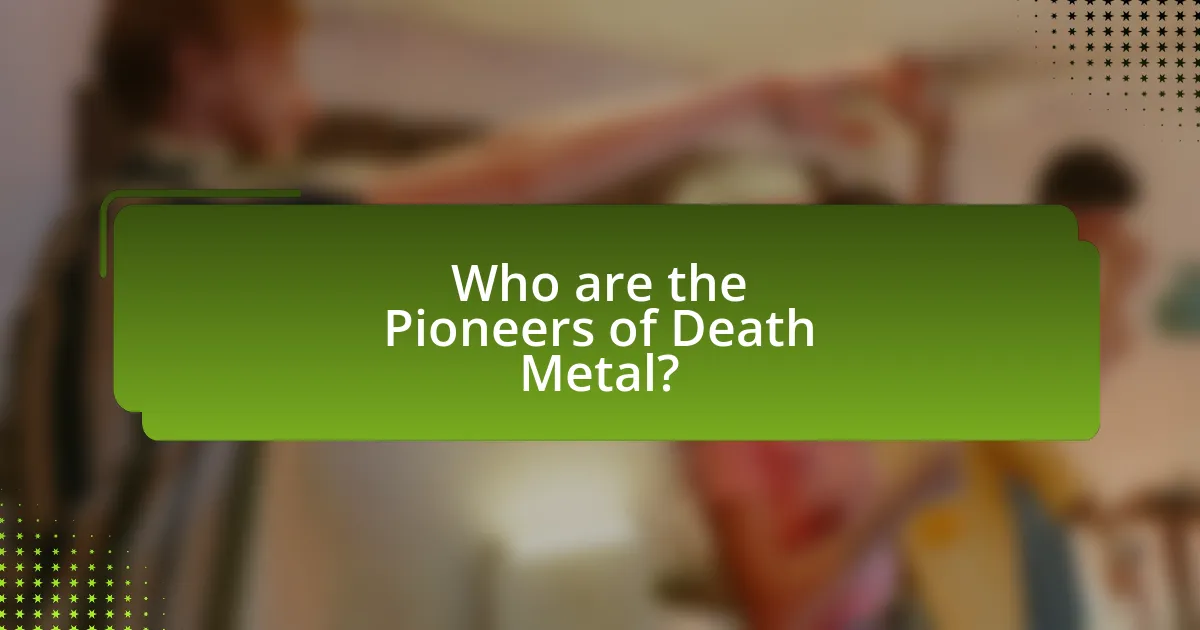
Who are the Pioneers of Death Metal?
The pioneers of death metal include bands such as Death, Possessed, and Morbid Angel. Death, formed in 1983, is often credited with creating the genre through their album “Scream Bloody Gore” released in 1987, which established the characteristic sound and themes of death metal. Possessed, with their 1985 album “Seven Churches,” is recognized for its aggressive style and lyrical content that focused on death and horror. Morbid Angel, emerging in the late 1980s, further defined the genre with their complex compositions and technical proficiency, particularly evident in their influential album “Altars of Madness” released in 1989. These bands collectively laid the groundwork for death metal, influencing countless artists and shaping the genre’s evolution.
What contributions did bands like Death and Morbid Angel make to the genre?
Death and Morbid Angel significantly shaped the death metal genre through their innovative musical techniques and lyrical themes. Death, led by Chuck Schuldiner, is credited with pioneering complex song structures and technical proficiency, as evidenced by their album “Symbolic,” which features intricate guitar work and progressive elements. Morbid Angel, known for their aggressive sound and dark themes, introduced a blend of speed and heaviness in albums like “Altars of Madness,” which set a standard for future bands in the genre. Both bands contributed to the establishment of death metal as a distinct musical style, influencing countless artists and solidifying the genre’s identity in the heavy metal landscape.
How did Chuck Schuldiner shape the sound of Death Metal?
Chuck Schuldiner significantly shaped the sound of Death Metal by pioneering complex song structures, intricate guitar work, and philosophical lyrics. As the founder of the band Death, he introduced elements such as tempo changes, dissonant harmonies, and a blend of melodic and aggressive styles, which became hallmarks of the genre. His 1991 album “Human” is often cited as a turning point, incorporating progressive elements and technical proficiency that influenced countless bands. Schuldiner’s emphasis on lyrical depth, addressing themes of existence and consciousness, also set a precedent for more thoughtful content in Death Metal, distinguishing it from other heavy music genres.
What innovations did David Vincent bring to the genre?
David Vincent brought significant innovations to the death metal genre, particularly through his work as the bassist and vocalist for Morbid Angel. He is credited with pioneering the use of complex song structures and intricate guitar riffs, which helped to elevate the technicality of death metal. Additionally, Vincent’s incorporation of growled vocals and dark, thematic lyrics set a new standard for vocal delivery and lyrical content in the genre. His influence is evident in the way subsequent bands adopted similar techniques, contributing to the evolution of death metal as a more sophisticated and diverse musical style.
Which other influential bands played a role in the Death Metal scene?
Influential bands that played a significant role in the Death Metal scene include Morbid Angel, Cannibal Corpse, and Obituary. Morbid Angel, formed in 1983, is often credited with pioneering the genre through their complex compositions and dark themes, particularly with their album “Altars of Madness” released in 1989. Cannibal Corpse, known for their graphic lyrics and aggressive sound, gained prominence with their 1990 album “Eaten Back to Life,” which helped define the brutal style of Death Metal. Obituary, emerging from Florida in the late 1980s, contributed to the genre’s development with their influential album “Slowly We Rot” in 1989, which showcased a heavier, more groove-oriented approach. These bands collectively shaped the sound and direction of Death Metal, establishing foundational elements that continue to influence the genre today.
What impact did Cannibal Corpse have on the genre’s popularity?
Cannibal Corpse significantly boosted the popularity of death metal through their aggressive sound and controversial imagery. Their 1990 album “Butchered at Birth” and subsequent releases showcased extreme musical techniques and lyrical themes that pushed the boundaries of the genre, attracting a dedicated fanbase. The band’s visibility increased with their appearances in mainstream media, including the film “Ace Ventura: Pet Detective,” which introduced death metal to a broader audience. Additionally, Cannibal Corpse’s relentless touring and participation in major music festivals helped solidify their status as a leading act in the genre, influencing countless bands and contributing to the overall growth of death metal in the 1990s and beyond.
How did Obituary contribute to the development of Death Metal’s sound?
Obituary significantly contributed to the development of Death Metal’s sound by pioneering a style characterized by heavy, downtuned guitars, aggressive drumming, and guttural vocals. Their 1989 album “Slowly We Rot” is often cited as a foundational work that helped define the genre’s sonic characteristics, blending elements of thrash metal with a more brutal and slower tempo. This album, along with their subsequent releases, showcased a raw production style and a focus on dark, morbid themes, influencing countless bands that followed. Obituary’s unique approach to songwriting and their emphasis on groove and heaviness set a standard for the Death Metal genre, solidifying their role as key architects in its evolution.
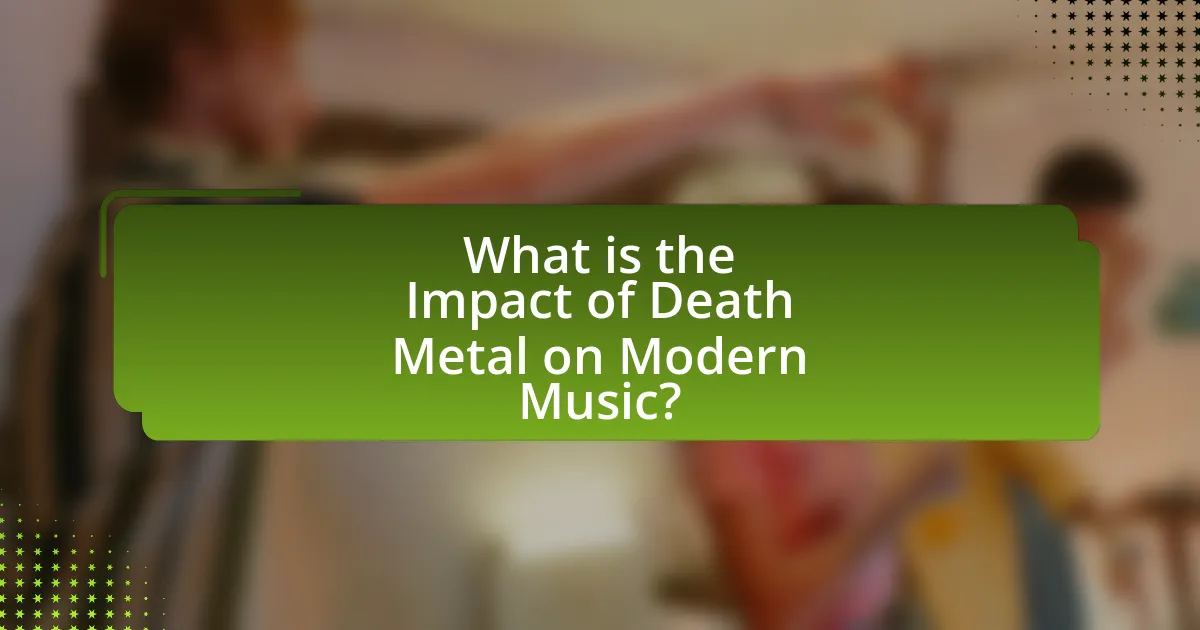
What is the Impact of Death Metal on Modern Music?
Death metal has significantly influenced modern music by introducing complex musical structures, aggressive vocal techniques, and thematic depth. Bands like Death and Cannibal Corpse pioneered intricate guitar riffs and time signatures that have permeated various genres, including metalcore and progressive metal. The genre’s emphasis on technical proficiency has led to a rise in musicianship standards across the music industry. Additionally, death metal’s exploration of darker themes has inspired artists in genres such as rock and electronic music, broadening the emotional and lyrical scope of contemporary music. This impact is evident in the works of modern bands that incorporate death metal elements, showcasing its lasting legacy in shaping the sound and direction of modern music.
How has Death Metal influenced contemporary metal subgenres?
Death Metal has significantly influenced contemporary metal subgenres by introducing complex song structures, aggressive vocal styles, and intricate guitar work. This genre’s emphasis on technical proficiency and thematic darkness has permeated various subgenres, including Metalcore and Progressive Metal. For instance, bands like Killswitch Engage and Opeth incorporate Death Metal’s growled vocals and complex rhythms, showcasing its impact on their sound. Additionally, the use of blast beats and dissonant chords, hallmarks of Death Metal, can be found in the music of modern bands such as Archspire and Rivers of Nihil, further evidencing its lasting legacy in shaping the evolution of metal.
What elements of Death Metal can be found in modern metalcore and deathcore?
Modern metalcore and deathcore incorporate several elements of death metal, including aggressive guitar riffs, complex song structures, and guttural vocal styles. These genres often feature breakdowns that emphasize rhythm and heaviness, a hallmark of death metal. Additionally, the use of blast beats and intricate drumming patterns is prevalent, reflecting the technical proficiency found in death metal. The thematic content in lyrics often mirrors the darker, more brutal themes typical of death metal, addressing topics such as violence, death, and existential despair. This blending of styles showcases the influence of death metal on the evolution of modern metalcore and deathcore, solidifying its legacy within these subgenres.
How do current bands pay homage to Death Metal pioneers?
Current bands pay homage to Death Metal pioneers by incorporating their musical styles, themes, and techniques into their own work. For instance, many contemporary bands emulate the complex guitar riffs and aggressive drumming patterns that characterized early Death Metal, as seen in the music of bands like Cannibal Corpse and Morbid Angel. Additionally, current artists often reference the lyrical themes of existentialism and mortality that were prevalent in the works of pioneers such as Death and Obituary. This homage is further evident in live performances, where modern bands frequently cover classic tracks from these influential groups, showcasing their respect and influence.
What role does Death Metal play in today’s music festivals and culture?
Death Metal plays a significant role in today’s music festivals and culture by influencing the diversity of lineups and fostering a dedicated community. This genre attracts large audiences at festivals, with events like Maryland Deathfest and Hellfest showcasing numerous Death Metal bands, highlighting its popularity and cultural relevance. Furthermore, Death Metal’s themes and aesthetics contribute to the broader metal culture, promoting values of individuality and rebellion, which resonate with fans. The genre’s technical musicianship and complex compositions have also inspired a new generation of musicians across various genres, reinforcing its impact on contemporary music culture.
How has the audience for Death Metal changed over the years?
The audience for Death Metal has evolved significantly over the years, transitioning from a niche group of dedicated fans in the late 1980s and early 1990s to a more diverse and global following today. Initially, Death Metal attracted primarily young males who were drawn to its extreme sound and lyrical themes, but as the genre has gained mainstream recognition, the demographic has broadened to include a wider age range and more female listeners.
This shift is evidenced by the increasing attendance at Death Metal festivals, which now feature a mix of genres and attract fans from various backgrounds. For instance, events like the Maryland Deathfest have seen attendance grow from a few hundred in its early years to thousands in recent editions, reflecting a growing interest in the genre. Additionally, the rise of social media and streaming platforms has facilitated greater accessibility to Death Metal, allowing fans to discover and engage with the music more easily, further diversifying the audience.
What are the current trends in Death Metal music and its community?
Current trends in Death Metal music include a resurgence of technical proficiency, blending of subgenres, and increased focus on lyrical themes that explore social and political issues. The community has seen a rise in diversity, with more female musicians and fans actively participating, as well as a growing acceptance of various influences from genres like black metal and grindcore. Additionally, the use of digital platforms for music distribution and community engagement has expanded, allowing for greater accessibility and interaction among fans and artists. This evolution reflects a broader cultural shift within the genre, emphasizing inclusivity and innovation while maintaining the core elements that define Death Metal.
What can fans learn from the legacy of Death Metal?
Fans can learn about the evolution of musical complexity and thematic depth from the legacy of Death Metal. This genre, pioneered by bands like Death and Morbid Angel, introduced intricate guitar work, unconventional song structures, and lyrical themes that explore existentialism, mortality, and societal issues. The technical proficiency displayed in albums such as “Symbolic” by Death, which is often cited for its sophisticated arrangements and musicianship, exemplifies how Death Metal pushed the boundaries of heavy music. Additionally, the genre’s influence on subsequent metal styles highlights its role in shaping the broader landscape of heavy music, demonstrating the importance of innovation and authenticity in artistic expression.
How can aspiring musicians draw inspiration from Death Metal pioneers?
Aspiring musicians can draw inspiration from Death Metal pioneers by studying their innovative techniques, lyrical themes, and unique sound structures. Pioneers like Chuck Schuldiner of Death and Glen Benton of Deicide pushed musical boundaries, incorporating complex time signatures and aggressive guitar riffs that defined the genre. Their exploration of dark and philosophical themes in lyrics can also inspire musicians to delve into deeper subject matter, enhancing their songwriting. Additionally, the DIY ethic and independent spirit of early Death Metal bands encourage aspiring artists to pursue their vision without conforming to mainstream expectations, fostering creativity and authenticity in their music.
What are the best practices for engaging with the Death Metal community?
To effectively engage with the Death Metal community, one should actively participate in discussions on dedicated forums and social media platforms, as these are primary venues for interaction. Engaging in conversations about favorite bands, albums, and concerts fosters connections with other fans. Additionally, attending live shows and festivals is crucial, as these events provide opportunities to meet like-minded individuals and experience the music culture firsthand. Supporting local bands by attending their performances and purchasing merchandise also strengthens community ties. Furthermore, sharing and promoting Death Metal content, such as reviews and playlists, helps to contribute to the community’s growth and visibility. These practices are validated by the community’s emphasis on shared experiences and mutual support among fans.
